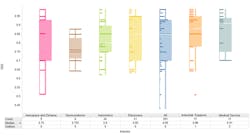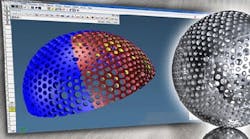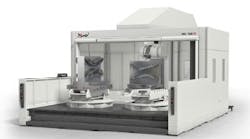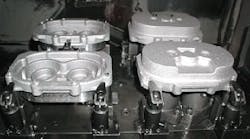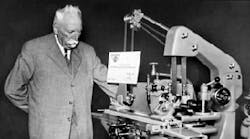As machine tools became more sophisticated, cutting tools became more complex.
Before World War II, high-speed-steel tooling was used for most metalcutting applications. Although cemented-carbide cutting tips had been around since the 1930s, many machines did not have the rigidity, power, and strength needed to optimize the use of this new tooling. However, with advances in machine-tool technology during the war years, which created more powerful production machines, cemented-carbide cutting tips came into fashion, and indexable inserts became the way to go.
Kennametal: A hard answer to the problem of cutting steel
Philip M. McKenna (1897-1969), founder of Kennametal Inc., was the inventor of WTiC2, a tungsten and titanium carbide composition that was the first commercially successful steel cutting carbide. A U.S. patent, issued April 5, 1938, for tungsten titanium carbide, marked the company's beginning in Latrobe, Pa.
The material, called Kennametal, was introduced in March 1938 by the newly formed McKenna Metals Co. because it met a very definite need, particularly for steel-cutting carbide. Growth of the company was rapid and substantial, as evidenced by the physical size of its plant and number of employees; the importance and significance of its projects; the scope of its activities; and the magnitude of its sales.
Manufacturing began with 12 employees in a small building with a floor space of 7,278 ft 2 . By 1949, there were more than 600 employees, and the plant floor area totaled 137,240 ft2
In 1938, only 20% of carbides used in the United States were used in a limited number of steel-cutting applications. Due to the attainment of the necessary combination of hardness, strength, and crater-resistance in Kennametal, within five years 80% of the carbides in use were steel-cutting grades.
During World War II, more than 50% of the shells produced in the United States were machined with Kennametal. It was also extensively used in the production of other war materials and equipment.
Poor business conditions of the late 1940s brought hard times for the young company. But new applications were developed for Kennametal materials and these, plus the economic expansion of the 1950s, launched the company into a period of considerable growth. New coal mining tools were developed, utilizing wear-resistant Kennametal tips at the cutting points. And new, longer lasting Kennametal tipped percussion bits were made for faster drilling of hard rock. Kennametal carbide knives were made for the woodworking industry and immediately demonstrated that they could far outwear steel knives.
Many applications were also recognized and developed for Kennametal as a material from which to make machine components subjected to extremes of wear. And, all the while, the line of Kennametal tools for the metalworking industry was being expanded and improved.
In the decade of the 1960s, Kennametal sales and earnings expanded at an annual compound growth of over 13%. Many new applications were developed for the hard carbide alloys during these years. And several new compositions or grades of Kennametal were introduced.
Sandvik Coromant: Tip grinding as critical as brazing
As early as 1939, Sandviken Steelworks AR (Sandvik) established a metallurgical research plant to investigate the manufacture of cemented carbide. On April 1, 1942, the company began manufacturing cemented carbide products: cutting tools, rock drills, and wear parts.
At the beginning of World War II, an agreement was entered into with AR Hammarby-Lampan (Luma) which was familiar with powder metallurgical methods because of its production of tungsten for filaments. The agreement involved Luma supplying the cemented carbide while Sandvik was to machine the blanks, manufacture the tools, and sell the finished products. In 1942, production of the product called "Coromant" began.
From the beginning, Coromant concentrated on manufacturing and selling complete tools, milling cutters, twist drills, reamers, and scrapers. These products were supplied in differing tool geometries and cemented carbide grades for machining various materials. Production began on the second floor of the hardening building in the steelworks in a facility known as the "hardening attic."
It was clear from the start that special expertise was needed not only in the brazing of the cemented carbide tip into a steel shank or milling cutter body, but also in the subsequent grinding of the cutting edge. Brazing stresses and careless grinding could induce cracks in the cemented-carbide tip that could cause cutting edge breakage and tool damage. On the other hand, accurate grinding or re-grinding of the cutting edge increased tool life two-fold, or more. As a result, in 1944, Sandvik set up grinding stations adjacent to its Swedish sales offices for the grinding and repair of customer tools. Customers were also instructed in the proper care and handling of cemented-carbide tools.
During the 1940s, Sandvik introduced several significant products including the first facemill with replaceable, brazed cutting units, a step milling cutter—a facemill for deep cutting depths—and a combination milling cutter with replaceable blades for different entering angles. In 1947, Sandvik acquired Luma's cemented-carbide manufacturing facilities and started its own development and manufacturing of cemented-carbide products.
Carboloy Inc.: Inserts ahead of their time
During the years of World War II, America's great Arsenal of Democracy had to meet its production needs without benefit of the high-efficiency cutting tools we now take for granted. In 1940, today's Carboloy Inc. was part of the General Electric Corp. By then, the company had successfully applied cemented-carbide technology to metalcutting tool manufacture, based on developments achieved by GE's Lamp Department.
Carboloy was the first, in the late 1920s, to introduce cemented-carbide inserts for commercial use, along with the toolholders needed to accommodate them.
The carbide cutting tips were a major advancement over the high-speed-steel tooling predominantly in use at that time. In the form of indexable "throwaway" inserts, they provided the economy of multiple cutting edges and low-cost replaceability, along with capabilities for greatly increased metal-removal rates and tool life.
It wasn't long before machine tools specially designed to take advantage of the higher metal-removal rates of these new carbides appeared on the market. New lathes with spindle speeds of 900 rpm appeared, as did boring mills with 1,000-sfm cutting speeds.
Carboloy introduced the first toolholders using screw-down insert retention to accommodate un-ground, disposable inserts with a molded chipbreaker. The company continues to develop new chipgroove geometries, applying CAD/CAM technology to enhance design flexibility and shorten lead times to market.
To accommodate the higher insert temperatures produced by increased speeds, feedrates, and cutting depths, Carboloy was the first to introduce aluminumoxide-coated carbide inserts for the U.S. market. The company has since made major strides in refining both coating technologies and deposition techniques.
Today's industry-wide turn-ing-insert selection programs— such as Carboloy's Secolor program— provide an immense advantage in selecting the right insert grade and chipgroove for an application. Such programs also support levels of metalcutting productivity and reliability that could only have been dreamed about in the past.
Iscar: A "Swiss-watch" approach to tool manufacturingTwenty years before Stef Wertheimer founded Iscar Ltd., the philosophical foundations were laid for this manufacturer of precision metalcutting tools. In 1937, when Wertheimer was 10 years old, his father immigrated from a small German village to Palestine. At 14, he opted for an apprenticeship in a Tel Aviv camera repair shop, rather than continue his formal education. Here, he learned the basics of optical engineering. Early in World War II, Wertheimer put this knowledge to work repairing bombsights and air conditioners for the British. In 1945 he was recruited for the Palmach—the volunteer combat forces of prestatehood Palestine—where he was put in charge of an underground munitions factory. Wertheimer realized that to make good guns, you had to have precise tools. From these experiences, he developed an intense commitment to Israeli self-sufficiency with entrepreneurism as its cornerstone. Wertheimer began Iscar Ltd. 14 years later and never forgot his commitment. The enterprise has grown to a group of precision tool manufacturing firm with annual sales of $320 million. Iscar Ltd. is one of Israel's leading export companies. Exports account for over 97% of sales through a global network of 25 subsidiaries and 25 agents in six continents. In 1976, Iscar created the first Grip tool, a unique design for cut-off applications which rapidly became widely accepted. This breakthrough was followed by the introduction of a group of multifunction turning, grooving, facing and threading tools. In 1982, Iscar moved its Tool Plant to Tefen in Galilee. By 1989 the Carbide Unit and Marketing Center were on-stream in new premises in Tefen. Beginning in 1990, Iscar focused on the creation of an entirely new line of milling tools. The same inserts could be used on a variety of milling cutter bodies for different applications. |
